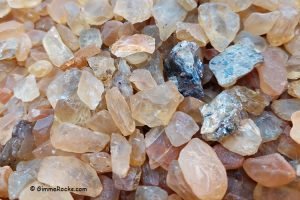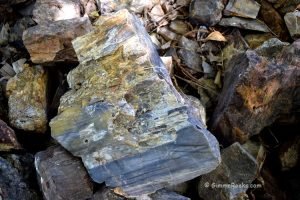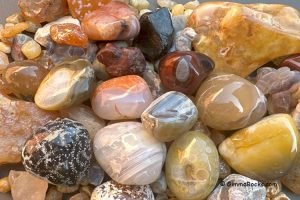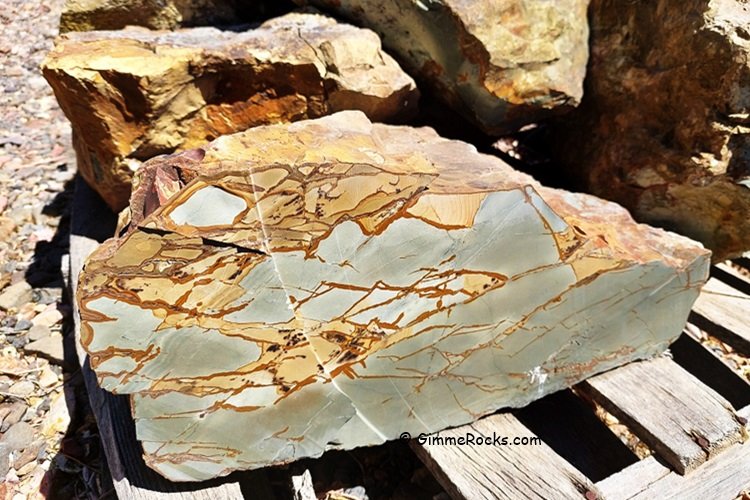
Jaspers is popular among rock collectors for its vibrant colors, unique patterns, and wide availability. It comes in many colors, including shades of red, yellow, brown, green, blue, and even multicolored patterns.
Jasper's patterns range from solid colors to complex banding, spots, streaks, and even the entire landscape in one stone.
Some of the jasper varieties include:
- Picture jaspers with landscape-like scenes
- Dendritic jaspers featuring tree- or fern-like inclusions
- Orbicular jaspers with spherical patterns
- Brecciated jaspers, displaying angular fragments cemented together by chalcedony or agate
- Imperial jaspers with vibrant red and green color combinations
Jasper has been used throughout history for jewelry, decoration, and even spiritual practices and derives its name from the ancient Greek word "iaspis" meaning "spotted stone."
These rocks can be found in volcanic rocks, sedimentary deposits, and even as pebbles in streams and along shorelines.
Jasper is an opaque, microcrystalline variety of quartz. The term "jasper" also includes a broader range of opaque chalcedony with the inclusion of various minerals. Some even display unique visual effects caused by the presence of water or gas bubbles during formation.
Like other forms of chalcedony, jasper is hard (6.5-7 on the Mohs scale) and acid-resistant. Jasper is composed primarily of silicon dioxide (SiO2).
Its microcrystalline structure differs from the more orderly crystal arrangement found in macrocrystalline quartz varieties like amethyst or citrine.
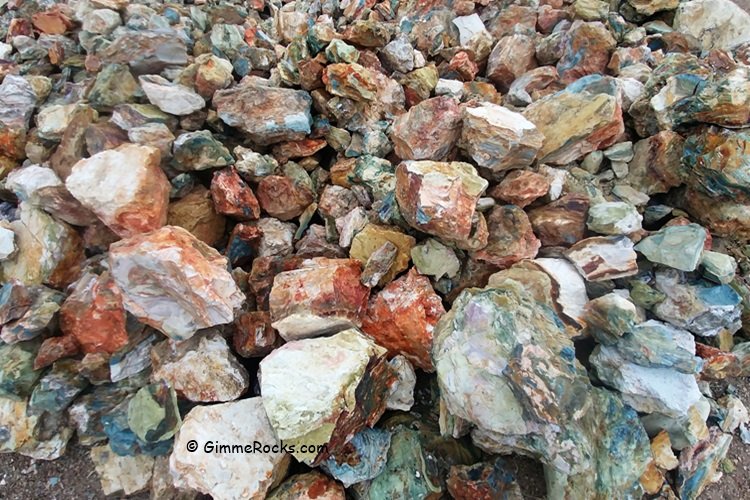
Jasper Formation
Jasper is formed by volcanic activity. Molten lava cools and hardens into rocks like basalts, andesites, and rhyolites. When gases trapped inside escape, leaving behind tiny cavities known as vesicles.
Over millions of years, mineral-rich groundwater percolates through these cavities, slowly depositing layers of silica and other minerals like iron oxides and hydroxides. This process, known as secondary mineralization, creates jasper's unique appearance.
The specific minerals present in the groundwater, as well as variations in the deposition process, create a range of colors and patterns.
Iron oxides like hematite produce rich shades of red and brown, while goethite contributes yellows and browns. Rarer colors like green and blue can occur due to the presence of minerals like chlorite or hematite.
As the silica and mineral impurities crystallize and harden within the vesicles, they form the microcrystalline quartz structure that defines jasper.
This structure is made up of tightly interlocking quartz crystals, giving jasper its signature opacity and durability. Depending on the specific conditions during formation, jasper may have banding, spots, streaks, or other unique patterns.
Over time, the host rock surrounding the jasper deposit weathers away, releasing the tough jasper nodules, veins, or fragments into the environment.
These pieces of jasper are then transported and deposited by rivers, waves, or glaciers, eventually ending up in the gravel beds, beaches, and rocky outcrops where collectors and rockhounds can find them.
Guide to Jasper Identification
Jasper Hardness – Knife Test
One of the key characteristics of jasper is its hardness, ranging from 6.5 to 7 on the Mohs scale. This means that jasper is harder than glass and cannot be scratched by a steel knife blade. To test a suspected jasper specimen, try gently scratching its surface with a knife.
It might be a jasper if the blade leaves no mark and simply glides across the stone. If a scratch appears, rub it with your finger to check if it is merely residue from the blade or an actual scratch in the stone.
Jasper Transparency – Using Light
While jasper is known for its opacity, it can sometimes be confused with translucent varieties of chalcedony, like agate. Hold the stone up to a strong light source to differentiate between the two.
If light passes through the rock, even partially, it is likely an agate or another form of translucent chalcedony. True jasper will remain completely opaque, blocking all light.
However, some agates, like the Lake Superior paint agate, can also be opaque, so consider other factors like banding patterns as well.
Jasper Color
Jasper varies in color from deep reds and vibrant yellows to earthy browns and mottled greens. Jasper's hues are created by the specific mineral impurities present during its formation.
Iron oxides like hematite produce the classic brick red and brownish-red tones, while goethite creates yellowish and brown hues. Iron hydroxides contribute to the rarer green jaspers, while finely disseminated hematite can create shades of blue.
In addition to solid colors, jaspers often have patterns of spots, streaks, or stripes in multiple hues.
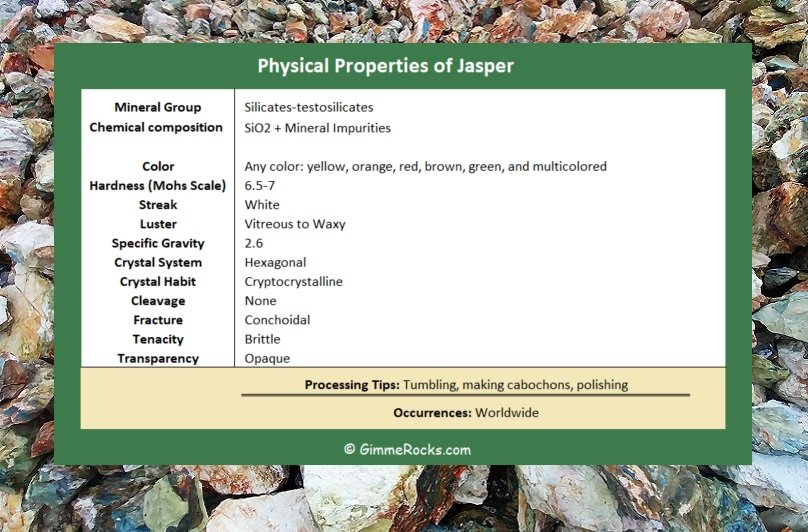
Jasper Banding
Another key characteristic of jasper is its banding patterns. Unlike the translucent, sharply defined bands often seen in agates, jasper's banding is opaque and less uniform.
Bands may be thick or thin, straight or wavy, and can range from subtle to bold, contrasting hues.
Some jaspers lack banding altogether, instead having random distributions of color and pattern. These unbanded specimens are technically a form of chalcedony, but the term "jasper" is often used in a broader sense by collectors and lapidary artists.
Dendritic jaspers, with their tree- or fern-like inclusions, moss jaspers with mossy green patterns, and flame or plume jaspers with vibrant red and yellow streaks, are all examples of unbanded jaspers.
Try wetting the surface with water to better observe any banding present in a rough jasper specimen. The moisture will enhance the contrast between different colored layers, making banding patterns more visible.
Jasper Luster
When polished, jasper typically exhibits a waxy to vitreous luster, adding depth and dimension to the stone's colors and patterns.
Rocks and Minerals Similar to Jasper
While jasper is distinctive, it can sometimes be confused with other minerals that share similar characteristics:
Agate: A translucent to semitransparent variety of banded chalcedony. Agate bands are typically more even and well-defined than jasper's irregular banding. Agates are also usually translucent, while jaspers are opaque.
Flint: Another form of microcrystalline quartz, flint is often darker than jasper and lacks distinct banding. It may be solid-colored or exhibit more subtle patterning.
Nephrite: A form of jade, nephrite is typically green and lacks the banding patterns seen in jaspers. It is also softer than jasper, with a Mohs hardness of 6.0-6.5.
To accurately identify jasper, look at multiple characteristics rather than relying on a single trait.
You can confidently distinguish jasper from similar-looking materials by evaluating hardness, transparency, color, banding patterns, and luster.
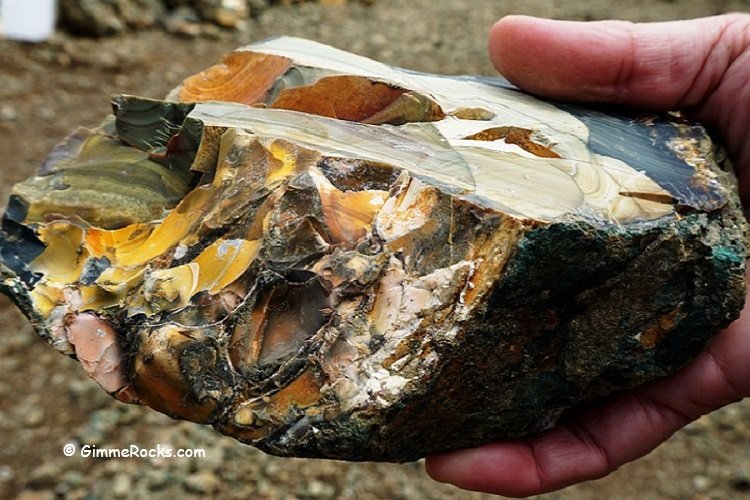
Jasper Varieties
There are countless types of jasper. Here are some of the most notable and sought-after jasper types.
Picture Jaspers: Characterized by elaborate scenes or landscapes created by multicolored banding and layering. Famous examples include Biggs Jasper, Bruneau Jasper, and Owyhee Jasper from Oregon and Idaho, as well as the Ocean Jasper from Madagascar.
Brecciated Jaspers: Formed when jasper is fractured and then re-cemented by chalcedony or agate, creating a distinctive angular, mosaic-like pattern. Examples include Canyon Creek Jasper from Arizona and Kabamba Jasper from Africa.
Orbicular Jaspers: Feature spherical or eye-like patterns created by radiating crystallization. Well-known varieties include Ocean Jasper and Poppy Jasper.
Dendritic Jaspers: Showcase tree- or fern-like mineral inclusions, often in black or brown against lighter backgrounds. Idaho's Willow Creek Jasper is a prime example.
Imperial Jaspers: Prized for their vibrant red and green color combinations, often with intricate swirling patterns. Imperial jasper varieties like the Royal Imperial jasper from Mexico are highly sought after by collectors and lapidary artists.
Mookaite Jasper: An Australian jasper known for its bold combinations of red, yellow, cream, and purple. Mookaite is believed to have formed from the silicification of ancient sediments and is popular in jewelry and lapidary work.
Madagascar's Ocean Jasper: A relatively recently discovered species with beautiful orbicular patterns in shades of pink, cream, and gray.
Where to Find Jaspers?
You can find jasper on every continent, and many locations have their own unique types of this rock.
In the United States, jasper is abundant in the volcanic regions of the West, including Oregon, Idaho, Washington, California, Arizona, and New Mexico.
Globally, there are significant jasper deposits in Australia, Brazil, Canada, Egypt, India, Indonesia, Madagascar, Mexico, Russia, and Venezuela.
Jasper is often found in riverbeds, beaches, and gravel deposits, where it has been weathered out of its host rock and concentrated by water action.

Value of Jasper
Most jasper rough is relatively affordable, with prices ranging from a few dollars to around $50 per pound (~1/2 kg), depending on the variety, pattern, and overall quality.
However, rare varieties like Imperial Jasper, Ocean Jasper, or exceptional picture Jaspers can command premium prices, especially for large, intact specimens with well-defined patterns.
Finished jasper products like cabochons, beads, carvings, and inlay work can also fetch significant sums depending on the quality of craftsmanship.
Processing Tips
Jasper can be worked with standard lapidary tools and techniques and is great for cutting, grinding, and polishing.
One of the most popular ways to showcase jasper is by cutting and polishing cabochons. Cabochons can be freeform or calibrated to specific sizes and shapes for use in jewelry or decorative objects.
Jasper is also an excellent choice for tumbling, as its hardness and durability allow it to withstand prolonged abrasion and produce a beautiful polish. Tumbled jasper stones are popular for use in jewelry, mosaics, or simply as decorative accents.
For jaspers with particularly striking patterns or scenes, a simple face polish may be the best way to showcase their beauty. Slabbed and polished jasper specimens make beautiful display pieces and can even serve as unique canvases for painting or engraving.
When working with jasper, take your time and study the rough material carefully to determine the best way to orient and cut the stone to maximize its visual impact.
Experimenting with different cutting angles, shapes, and polishing techniques can unlock the unique shape.

